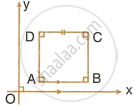Advertisements
Advertisements
प्रश्न
Show that points P(1, –2), Q(5, 2), R(3, –1), S(–1, –5) are the vertices of a parallelogram.
उत्तर
Let, P(1, −2) = (x1, y1); Q(5, 2) = (x2, y2); R(3, −1) = (x3, y3) and S(−1, −5) = (x4, y4).
By distance formula,
PQ = `sqrt((x_2 - x_1)^2 + (y_2 - y_1)^2)`
= `sqrt((5 - 1)^2 + [2 - (-2)]^2)`
= `sqrt((4)^2 + (4)^2)`
= `sqrt(16 + 16)`
= `sqrt32`
= `sqrt(2 xx 2 xx 2 xx 2 xx 2)`
= `4sqrt2` ...(1)
QR = `sqrt((x_3 - x_2)^2 + (y_3 - y_2)^2)`
= `sqrt((3 - 5)^2 + (-1 - 2)^2`
= `sqrt((-2)^2 + (-3)^2)`
= `sqrt(4 + 9)`
= `sqrt13` ...(2)
RS = `sqrt((x_4 - x_3)^2 + (y_4 - y_3)^2)`
= `sqrt((-1 - 3)^2 + [-5 - (-1)]^2)`
= `sqrt((-4)^2 + (-4)^2)`
= `sqrt(16 + 16)`
= `sqrt32`
= `sqrt(2 xx 2 xx 2 xx 2 xx 2)`
= `4sqrt2` ...(3)
PS = `sqrt((x_4 - x_1)^2 + (y_4 - y_1)^2)`
= `sqrt((-1 - 1)^2 + [-5 - (-2)]^2)`
= `sqrt((-2)^2 + (-5 + 2)^2)`
= `sqrt((-2)^2 + (-3)^2)`
= `sqrt(4 + 9)`
= `sqrt13` ...(4)
In `square`PQRS,
PQ = RS ...[From (1) and (3)]
QR = PS ...[From (2) and (4)]
`square`PQRS is a parallelogram. ...(A quadrilateral is a parallelogram if both the pairs of its opposite sides are congruent.)
Points P(1, –2), Q(5, 2), R(3, –1), S(–1, –5) are the vertices of a parallelogram.
संबंधित प्रश्न
A slope of a line is 3 and y-intercept is –4. Write the equation of a line
Find the slope of the line perpendicular to AB if : A = (0, −5) and B = (−2, 4)
(−2, 4), (4, 8), (10, 7) and (11, –5) are the vertices of a quadrilateral. Show that the quadrilateral, obtained on joining the mid-points of its sides, is a parallelogram.
The side AB of a square ABCD is parallel to the x-axis. Find the slopes of all its sides. Also, find:
- the slope of the diagonal AC.
- the slope of the diagonal BD.

Find the slope and the inclination of the line AB if : A = `(0, - sqrt(3))` and B = (3, 0)
Find the slope of the line which is parallel to `x/2 - y/3 -1 = 0 `
Find k, if R(1, –1), S (–2, k) and slope of line RS is –2.
Find the slope of a line passing through the following pair of point
(²m²,2am) and (p²m²,2pm)
Find the slope of a line passing through the following pair of points
(5pq,p2q) and (5qr,qr2)
Find the slope and the y-intercept of the following line 5x - 2y = 6
Find the slope and the y-intercept of the following line 2x + 3y = 12
Verify whether the following points are collinear or not:
A(1, –3), B(2, –5), C(–4, 7).
A line passing through the points (a, 2a) and (- 2, 3) is perpendicular to the line 4a + 3y + 5 = 0. Find the value of a.
Prove that A(4, 3), B(6, 4), C(5, 6) and D(3, 5) are the angular points of a square.
Find the image of a point (-1, 2) in the line joining (2, 1) and (- 3, 2).
The vertices of a triangle are A(10, 4), B(- 4, 9) and C(- 2, -1). Find the
Determine whether the following points are collinear. A(–1, –1), B(0, 1), C(1, 3)
Given: Points A(–1, –1), B(0, 1) and C(1, 3)
Slope of line AB = `(square - square)/(square - square) = square/square` = 2
Slope of line BC = `(square - square)/(square - square) = square/square` = 2
Slope of line AB = Slope of line BC and B is the common point.
∴ Points A, B and C are collinear.
What is the name of the point of intersection of coordinate axes?
If the lines kx – y + 4 = 0 and 2y = 6x + 7 are perpendicular to each other, find the value of k.
